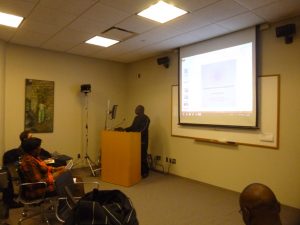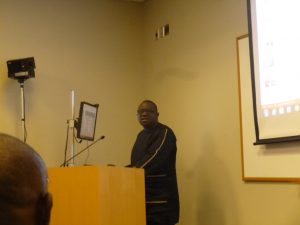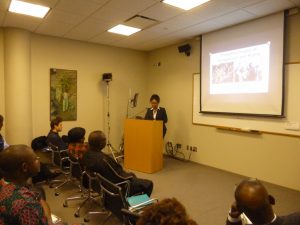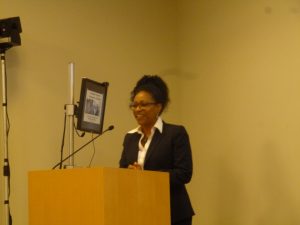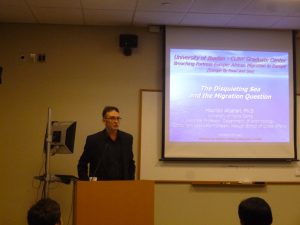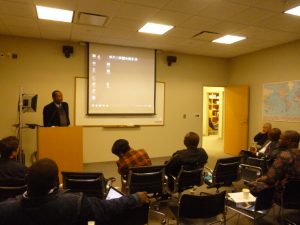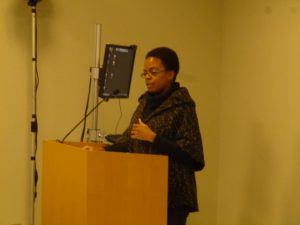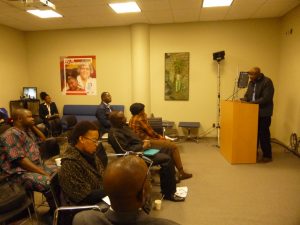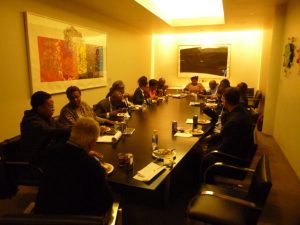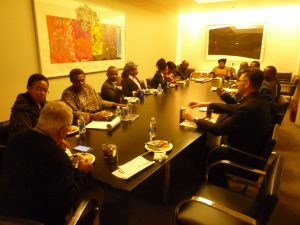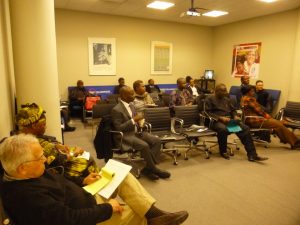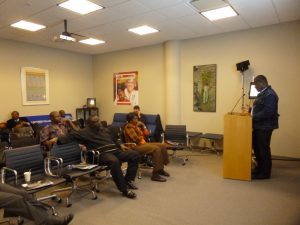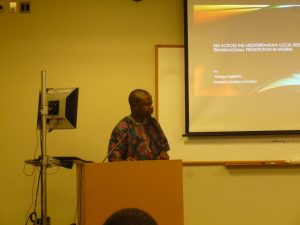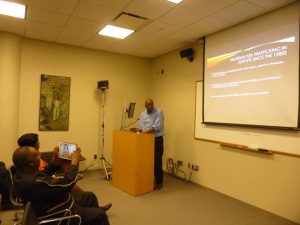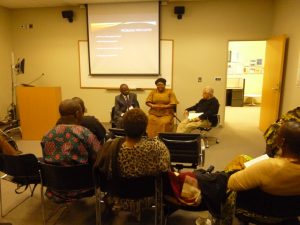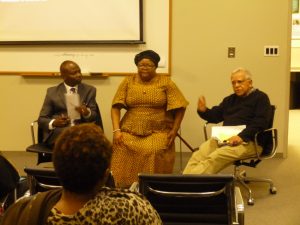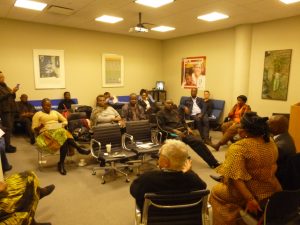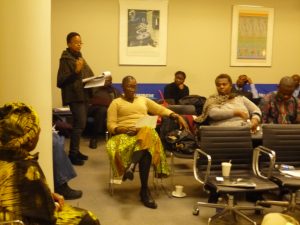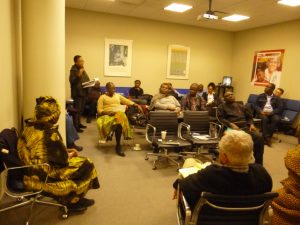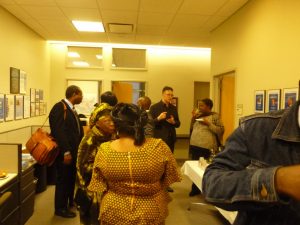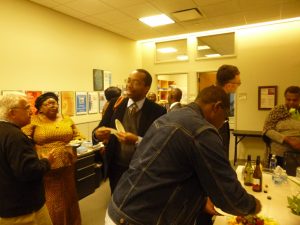Notes Towards a Clarifying Response to Gagnon
Cristian R. Aquino-Sterling
Advanced Research Collaborative (ARC) Fellow
Spring – Summer, 2016
“The greatest task of education as we enter the 21st century is to address pedagogically the radical reconfiguration of social life brought on by the proliferation of multiplicity and difference.”
—Dimitriades & McCarthy (2001).
“It is not that people use language varieties because of who they are, but rather that we perform who we are by (among other things) using varieties of language.”
—Pennycook (2003).
Conducting research on how bilingual teacher education programs in California and New York City prepare future K-12 bilingual teachers for the work of content-area instruction in Spanish is not without its conceptual and methodological challenges. At a conceptual level, this work presupposes (1) that, despite it being a “discursively constructed artifact” (del Valle, 2015), Spanish and its varieties are distinctive and linguistically recognized forms of communication; (2) that “proficiency” in any language (variety) can be assessed, evaluated, and developed (Douglass, 2000; Shohamy, 1996); and (3) that in employing a “repertoire of complex linguistic resources” (Valdés, 2015) to carry out multiple pedagogical language tasks, K-12 bilingual teachers also require to draw on features of what dominant society has constructed as ‘standard,’ ‘academic’ and ‘disciplinary’ forms of Spanish (Regueiro Rodríguez & Sáez Rivera, 2015).[i]
However, the cultivation of socially dominant “communicative repertoires” (Rymes, 2010) does not imply the inherent deficiency of language features and practices that traditionally have not been recognized or legitimized as ‘standard,’ ‘academic,’ and/or ‘disciplinary.’ In the same way, the cultivation of socially dominant linguistic repertoires and practices does not exclude bilingual teacher educators (and, therefore, K-12 bilingual teachers) from fostering and equally valuing bilingual students’ full linguistic repertoires, including their “fluid bilingual languaging” practices (García, 2014). In order to affirm the often marginalized cultural and linguistic identities of their students, K-12 bilingual teacher educators (and, therefore, K-12 bilingual teachers) must design teaching and learning contexts in which the wide range of multilingual resources characterizing the classroom community functions as an authentic and legitimate vehicle for the co-construction of ‘academic’ forms of knowledge beyond the use and the privileging of the “monoglot ‘standard’” (Silverstein, 1996).[ii]
However, it is important to remember that certain language varieties (e.g., African-American Vernacular English; Chicano Spanish) and modalities (code-switching; translanguaging) have not achieved communicative legitimacy within so-called ‘elite’ and/or ‘mainstream’ contexts of language use (e.g., ‘scholarly’/’academic’ knowledge production), due in large part to the workings of the capitalist market system. Within our capitalist system of production, the social stratification of language(s)—the ascription of higher social, economic, and ‘academic’ value to selected languages, language features, and practices—is likely to persist as the modus operandi unless we adhere to a new economic model in which stratification does not function as a prerequisite for the survival of the system—and language, therefore, is no longer treated as a ‘commodity.’
In a society where individuals are prone to compete for resources, the macro-level forces of social stratification that regulate linguistic exchanges (Bourdieu, 1999) exert unequivocal influences on micro-level contexts (e.g., bilingual teacher education classrooms; K-12 bilingual classrooms). As such, micro-level adaptations intended to counter the stratifying effects of market forces are undeniably subject to the greater influence of macro-economic forces.[iii] Moreover, to the degree that ownership of the means of production and economic authority remain in the hands of selected ‘elite’ groups, micro-level proposals for disrupting the effects of market forces have the potential to remain relevant and effective only at the micro-levels of social life (e.g., multilingual school contexts). Given these dynamics, and in order to engage in the ‘academic’/’professional’ life of so-called ‘mainstream’ society, it is imperative (although not always sufficient) for minoritized (emergent) bilingual student populations to learn to employ the linguistic resources that dominant society has established as ‘legitimate’—sought after and guarded linguistic commodities, dangerous for all to acquire.[iv]
Because I do not see my research on how bilingual teacher education programs prepare future teachers for the work of teaching content-area knowledge in Spanish as advocating the dismantling of our current capitalist economic model, and inasmuch as I do advocate for the legitimacy of all linguistic repertoires, I believe future K-12 bilingual teachers (and their future K-12 bilingual students) have the right to be socialized into the language/discourse practices of ‘dominant’ society—unless, of course, these social actors make a conscious choice to resist being initiated into these practices. Although I realize that notions of ‘standard’ ‘academic’ and ‘professional’ language are indeed social constructions (Berger & Luckmann, 1966), I also know that not being able to employ forms of language expected within particular ‘academic’ or ‘professional’ contexts may entail concrete material consequences.
As indicated in previous research (Aquino-Sterling, 2016):
Ideally, within a U.S. Latino context, bilingual teacher education classrooms should aspire to become communities of non-compartmentalized bilingual language practices where all course participants are able to exercise the right to translanguage (García, 2014) or “ [to] deploy [… ] [their] full linguistic repertoire without regard for watchful adherence to the socially and politically defined boundaries [of any] language [or language variety],” and without having to feel insecure and/or ashamed of the language performances they feel most comfortable enacting (Otheguy, García, & Reid, 2015, p. 283). However, given the power structures in our society, I believe it is crucial for all students in K– 12 and beyond, including future bilingual teachers, to diversify their language competence ‘ toolbox’— their “ repertoire of complex linguistic resources” (Valdés, 2015, p. 268)— and acquire the language [forms] of power (Delpit, 1993). This will ensure they are not at a disadvantage when required to produce formal, ‘academic,’ and ‘professional’ forms of discourse across social contexts” (p. 54).
As critical-educational scholars, it is of outmost importance to deconstruct naturalized notions of ‘standard,’ ‘academic,’ ‘disciplinary,’ and ‘professional’ forms of language. However, we must be mindful of the potential unintended consequences of espousing language pedagogies that, in their rightful and much-needed intent to affirm and legitimize the varied cultural and linguistic identities of minoritized (bilingual) learners, could also serve to deprive them of opportunities to acquire forms of linguistic capital that are still operative, valued, and guarded within the logics of an unyielding and evermore expanding capitalist system of production and social stratification. Unless, of course, our intent is also to work earnestly to disrupt the macro-level system that re-produces such inequities while ensuring that these students do not unintentionally become “the miner’s canary” (Guinier & Torres, 2002).
On ‘Proficiency’ and ‘Pedagogical Spanish’
In conducting a review of the literature on Spanish in bilingual teacher education, I found that scholars in the field have generally characterized the K-12 bilingual teacher population as exhibiting “low levels” of Spanish proficiency. Although the literature reviewed at times unjustifiably attributes this “low level” of proficiency to the often marginalized language practices characteristic of second-language speakers, heritage language speakers, simultaneous bilinguals, and/or individuals who employ an ethnically-identified language variety (e.g. Chicano Spanish), in my study I define proficiency in contextual rather than absolute terms. Absolute proficiency (AP) pertains to the implicit and erroneous idea that a speaker is proficient in a language to the degree that she is able to perform language functions in the “standard” language variety; in other words, to the degree the speaker’s performance approximates the performance of an illusive “native” and “educated” speaker (as defined by ACTFL; the Common European Framework of Reference for Languages; the Real Academia de la Lengua Española). Contextual proficiency (CP), on the other hand, rejects the idea of proficiency as a function of standard language practices. Rather, contextual proficiency provides us with an inclusive and democratic understanding of the communicative act and posits that human beings can exhibit language proficiency in any language (Spanish, English), language variety (e.g., Chicano Spanish; African American Vernacular English), and/or modality (codeswitching; translanguaging). As I conceive of it, contextual proficiency refers to a speaker’s capacity to meet any functional language task (e.g. describe, explain, question, hypothesize, formulate argument/opinion, etc.) employing any language variety or modality appropriate or relevant to the context of the communicative act.
Emerging from the idea of contextual proficiency (CP), teaching-specific or pedagogical Spanish serves as a viable approach for assessing and developing the academic-pedagogical aspect of pedagogical Spanish as discourse, namely: “[…] the language and literacy competencies bilingual teachers require for the effective work of teaching in Spanish across the curriculum in K– 12 bilingual schools […]” (Aquino-Sterling, 2016, p. 51). As originally conceived, and as Gagnon rightly indicates in his commentary, this model did not include or made explicit the goal of also integrating the often marginalized and hybrid language practices of simultaneous bilinguals. (As indicated above, in bilingual school classrooms students have the right and should be given the opportunity to perform language functions in a variety of language and modalities, drawing on their full linguistic repertoire.) However, this omission did not derive from upholding a deficit view of particular forms of language, as we find articulated in concepts such as the “word gap” (Fuller et al., 2015); “semilingualism” (Cummins, 2000); the “underdeveloped code” (Valdés & Geoffrion-Vinci, 1998), or the “restricted code” (Bernstein, 1971). The idea of “low” levels of Spanish proficiency in so-called ‘standard,’ ‘academic,’ and/or ‘professional’ Spanish varieties should not be understood, necessarily, as being complicit in perpetuating deficit views of non-dominant language varieties, practices, and/or modalities when proficiency is understood in contextual rather than absolute ways. Although it proved difficult to fully articulate this perspective during my ARC lecture, I find it important to include it here as a clarifying response to Gagnon´s commentary and in order to avoid further misunderstandings.
For an explicit version of a more inclusive “pedagogical Spanish” model, please refer to an article I have co-authored (Aquino-Sterling & Rodríguez-Valls, 2016, Multicultural Perspectives) entitled, “Developing Teaching-Specific Spanish Competencies in Bilingual Teacher Education: Towards a Culturally, Linguistically, and Professionally Relevant Approach.”
[i] Within bilingual classroom contexts, teachers are called to meet the language/discourse demands of pedagogical communicative tasks characteristic of multidisciplinary and academic classroom/school life (e.g., modeling for a student how to conceptualize and orally express a structured scientific argument in multiple languages, language varieties, and/or modalities, including in ways valued by the greater academic/scientific community).
[ii] Within poststructural/postmodern approaches to [linguistic] identity construction and performance (Hall, 1992; Norton, 2000; Pennycook, 2003; Sarup, 1993; 1996) the assertion “I am my language” is no longer a sufficient explanation of linguistic identity construction. Rather, the assertion “I am my languages” becomes a more relevant explanation for contemporary forms of adscriptions to non-essential and multiple social and linguistic identities.
[iii]At the micro-level of the classroom, valuing the linguistic repertoires represented is a necessary and worthy adjustment. However, classrooms and their students do not live in isolation from greater social and economic structures. Making the familiar strange by deconstructing the social categories that ascribe higher values to dominant forms of communication is important inasmuch as we also recognize the social value of these forms and the right of minoritized students to access these, given the reproductive nature of economic and social structures. The bilingual classroom should serve as a microcosm that both affirms and expands the social and linguistic experiences of its participants.
[iv] Lisa Delpit has been a key figure in helping us transition from deficit perspectives of language use to acknowledging the non-inherent yet higher socioeconomic value dominant society has allocated to certain forms of language. Delpit also emphasizes a teacher’s ethical responsibility to facilitate a classroom context where minoritized students acquire/learn “codes of power” (2006) or “discourses of power” (1993).





